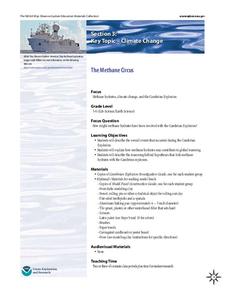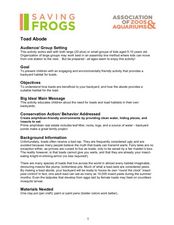Curated OER
Fossil Footsteps
Fourth graders create their own dinosaur tracks using clay. In addition, 4th graders compose a story about the dinosaur / animal who created the tracks. They study photographs of dinosaur tracks before beginning.
Curated OER
Eco-enrichers
Students discover the importance of plant and animal components within soil. In this soil lesson, students test the quality of soil. Students then conduct an experiment adding different components to bags of soil to see what will...
Curated OER
Plant And Animal Cells
Students identify parts of plant and animal cells and describe the functions of each part. They distinguish between plant and animal cells. After a lecture/demo, students perform experiments which help them construct models of plant and...
Curated OER
Animals in Art
Second graders demonstrate visual awareness by listing seven to nine types of animals shown in the artwork on the tour. They draw three types of textured lines or patterns shown in the tour artwork and model an imaginary animal using clay.
Perkins School for the Blind
Chromosome Models- Karyotyping
Create your own karyotypes with clay in a kinesthetic genome activity. This tactile experience was created for visually impaired pupils, but can be used for all hands-on learners who are beginning to study chromosomes. The preparation...
Curated OER
Animals of Point Reyes
Seventh graders explore how disasters affect animals. In this animal habitats lesson students create an animal that will survive in Point Reyes habitats.
Curated OER
Building a Clay Neuron
Students examine the anatomy of a neuron and its physiology. In this neuron lesson students build a representative model of a biological structure.
Curated OER
Building a Clay Neuron
Middle schoolers investigate and then build neurons in this lesson. They are examined as key parts of the brain and nervous system and seen as different from normal cells.
Curated OER
Animal Behavior: "Groggy Goldfish"
Students observe goldfish in different environments. In this biology lesson plan, students watch the behavior of goldfish in water of varying temperatures.
NOAA
Climate Is Our Friend…Isn’t It?: Make an Extinction Polyhedron
Climate affects populations in different ways. Scholars research extinct organisms and mass extinctions in part three of the 10-installment Discover Your Changing World series. They create graphic organizers, then fill in the information...
Curated OER
Be Brain Smart
Students examine the function of the brain. Using the internet, they research facts of the brains of vertebrates. Using clay, they make three sculptures of brains of different vertebrates and use crayola colors to color it. To end the...
Curated OER
Alligator
Middle schoolers create a model of an alligator out of clay using both artwork and research to guide their finished work.
Curated OER
21st Century Medicine: Nerves of Steel
Learners model a sarcomere's action, they gain a kinesthetic and visual understanding of muscle contraction. They use this exercise stimulates the production of myosin and actin. Students use two colors of clay, make a "sandwich" of...
Curated OER
Marine & Aquatic Habitats Activities - Aquatic Animals
Learners explore importance of marine or aquatic habitats, and investigate habitat characteristics and conditions required by various organisms to ensure survival. They then select an animal to study and design an artificial habitat...
Curated OER
Structural and Behavioral Adaptations
Learners participate in a role playing lab that allows students to experience how different beak adaptations play a role in the type of food the animal can eat, therefore playing a role in the survival of the species.
Curated OER
Explore: 2nd Grade Camouflage
Second graders discuss camouflaging in animals. They create camouflaged animal artwork out of various craft and art supplies and then see how well the creation blends into an outdoor area.
Curated OER
Mammal Facts and Myths
Learners write a report. In this mammals lesson, students learn about various mammals such as whales, beavers, bats and echidnas. Learners make a diagram, write a report, brainstorm a list of myths and make a model animal.
Curated OER
The Big Hideout
Middle schoolers identify the types of camouflage used by animals in the desert. They work together to create their own animal creating their own type of camouflage. They determine how well the camouflage works.
Curated OER
Lesson Plans for Winter
Learners participate in several winter-themed lessons. In this seasonal lesson, students study penguins and polar bears by animal masks for dramatic play. Additionally, learners construct winter calendars and celebrate the season of...
NOAA
The Methane Circus
Step right up! An engaging research-centered lesson, the third in a series of six, has young archaeologists study the amazing animals of the Cambrian explosion. Working in groups, they profile a breathtaking and odd creature and learn...
Curated OER
Amazing Desert Dwellers
Students explore the many adaptations desert animals have made to survive in their challenging habitat. They use this information to invent new creatures well-suited for desert life.
Curated OER
Toad Adobe
Students explore the importance of toads and the need for toad habitats in the environment. In this animal habitats lesson, students create an adobe habitat for toads by using a clay pot. Students paint their pots and place them in their...
Curated OER
Hands-on Cells
Middle schoolers review the components of a cell and the differences between plant and animal cells by creating a three-dimensional model of each type of cell. In small groups, they use modeling clay and household object to construct...
Curated OER
Teeth Identification in Omnivores, Herbivores and Carnivores
Students practice identifying teeth. In this biology lesson plan, students explore the differences in teeth structure and how it determines what a specific animal eats by constructing a raccoon puppet.
Other popular searches
- Clay Animation Movie
- Clay Animation Toys
- Rainforest Clay Animation
- Sculptures Clay Animation
- Rain Forest Clay Animation
- Clay Animation Africa
- Clay Animation Pre K
- Clay Animation Pre K
- Clay Animation "Lesson
- Clay Animation "Lesson"
- Clay Animation Prue K
- Clay Animation Lesson

























